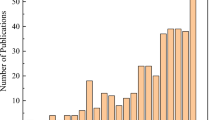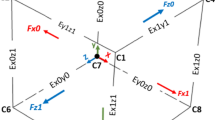Abstract
Lightweight porous foams have been of particular interest in recent years, since they have a very unique set of properties which can be significantly different from their solid parent materials. These properties arise from their random porous structure which is generated through specialized processing techniques. Their unique structure gives these materials interesting properties which allow them to be used in diverse applications. In particular, highly porous Al foams have been used in aircraft components and sound insulation; however due to the difficulty in processing and the random nature of the foams, they are not well understood and thus have not yet been utilized to their full potential. The objective of this study was to integrate experiments and simulations to determine whether a relationship exists between the relative density (porous density/bulk density) and the mechanical properties of open-cell Al foams. Compression experiments were performed using an Instron Universal Testing Machine (IUTM) on ERG Duocel open-cell Al foams with 5.8% relative density, with compressive loads ranging from 0–6 MPa. Foam models were generated using a combination of an open source code, Voro++, and MATLAB. A Finite Element Method (FEM)-based software, COMSOL Multiphysics 4.3, was used to simulate the mechanical behavior of Al foam structures under compressive loads ranging from 0–2 MPa. From these simulated structures, the maximum von Mises stress, volumetric strain, and other properties were calculated. These simulation results were compared against data from compression experiments. CES EduPack software, a materials design program, was also used to estimate the mechanical properties of open-cell foams for values not available experimentally, and for comparison purposes. This program allowed for accurate prediction of the mechanical properties for a given percent density foam, and also provided a baseline for the Al foam samples tested via the IUTM method. Predicted results from CES EduPack indicate that a 5.8% relative density foam will have a Young’s Modulus of 0.02–0.92 GPa while its compressive strength will be 0.34–3.37 MPa. Overall results revealed a relationship between pores per inch and selected mechanical properties of Al foams. The methods developed in this study can be used to efficiently generate open-cell foam models, and to combine experiments and simulations to calculate structure-property relationships and predict yielding and failure, which may help in the pursuit of simulation-based design of metallic foams. This study can help to improve the current methods of characterizing foams and porous materials, and enhance knowledge about theirproperties for novel applications.
Similar content being viewed by others
References
M.F. Ashby, A.G. Evans, N.A. Fleck, L.J. Gibson, J.W. Hutchinson and H.N.G. Wadley, in Metal Foams: A Design Guide, edited by M.F. Ashby (Elsevier Science Publisher, Burlington, MA, 2000) pp. 6–52.
J. Luyten, S. Mullens and I. Thijs, KONA Powd. Part. J. 28, 131–142 (2010).
Handbook of Cellular Metals: Production, Processing, Applications, edited by H.P. Degischer and B. Kriszt, (Wiley-VCH, Germany, 2002).
ERG Duocel® Aluminum Foam website. August 15, 2013 from http://www.ergaerospace.com/Aluminum-properties.htm
B.F. Oliveira, L.A.B. da Cunda and G.J. Creus, Mechanics of Advanced Materials and Structures, 16(2), 110–119 (2009).
P.J. Veale, M.S. Thesis, University of Massachusetts Amherst, 2010.
R. Cooke, M.S. Thesis, Naval Postgraduate School, 2001.
A.M. Kraynik and D.A. Reinelt, Foam microrheology: From honeycombs to random foams (online documentation: http://faculty.smu.edu/reinelt/foam_rheology.pdf). Engineering Sciences Center, Sandia National Laboratories, Albuquerque, NM, 1999.
Voro++ website. July 15, 2013 from http://math.lbl.gov/voro.
COMSOL Multiphysics 4.3. The COMSOL Group (2013) website. June 15, 2013 from http://www.comsol.com.
MATLAB. MathWorks Group (2013) website. July 12, 2013 from http://www.mathworks.com/products/matlab.
CES EduPack. Granta Material Intelligence (2013) website. August 10, 2013 from http://www.grantadesign.com.
M. Larner and L.P. Dávila, The Mechanical Properties of Porous Aluminum using Finite Element Method Simulations and Compression Experiments, Mater. Res. Soc. Symp. Proc. 1580, mrss13-1580-bbb09-05, doi:10.1557 / opl.2013.663 (2013).
W.-Y. Jang, S. Kyriakides and A.M. Kraynik, On the Compressive Strength of Open-Cell Metal Foams with Kelvin and Random Cell Structures, Int. J. Solids Struct. 47, 2872–2883 (2010).
acknowledgments
The authors want to thank B. Doblack, M. Diaz Moreno, T. Allis and M. Dunlap at UC Merced for their technical assistance with this project. Also, Chris Rycroft at UC Berkeley for his assistance with the Voro++ random cell generator. An NSF-CAMP Student Research Funds award supported co-author (JA) for this work. In addition, NSF-COINS awards supported coauthors (JA and ML), providing funds for the summer portion of the work. This work was performed under the auspices of the NSF-funded COINS award under contract No. 0832819.
Author information
Authors and Affiliations
Corresponding author
Rights and permissions
About this article
Cite this article
Larner, M., Acker, J. & Dávila, L.P. The Random Porous Structure and Mechanical Response of Lightweight Aluminum Foams. MRS Online Proceedings Library 1662, 7–15 (2014). https://doi.org/10.1557/opl.2014.264
Published:
Issue Date:
DOI: https://doi.org/10.1557/opl.2014.264




